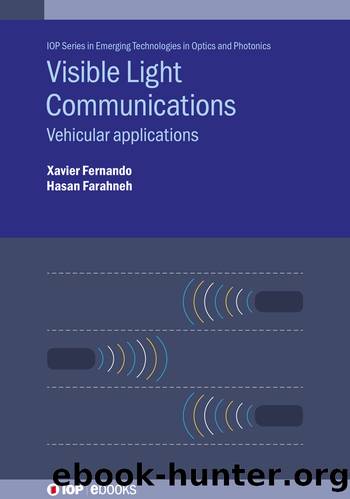Visible Light Communications: Vehicular applications by Xavier Fernando Hasan Farahneh

Author:Xavier Fernando, Hasan Farahneh
Language: eng
Format: epub
ISBN: 9780750322843
Publisher: IOP Publishing
Published: 2019-11-08T00:00:00+00:00
* * *
IOP Publishing
Visible Light Communications
Vehicular applications
Xavier Fernando and Hasan Farahneh
* * *
Chapter 3
Optical OFDM basics
VLC channels have inherent scattering and reflection properties and undergo destructive effects of multipath dispersion. This results in ISI and leads to a reduced data rate. In order to mitigate ISI, time domain equalization (TDE) technique is used in single-carrier and OFDM is used in multi-carrier communication systems [1]. OFDM has been implemented in many wireless RF and wireline standards and has also proved to be beneficial in VLC systems [2]. O-OFDM schemes have better optical power efficiency, reduced ISI and very low BER, compared to conventional optical modulation schemes such as OOK and pulse position modulation (PPM) [3].
MIMO systems have gained considerable attention in VLC networks due to their high data rate capabilities over longer distances despite multipath dispersion interference effects. The combination of OFDM and MIMO is considered a powerful physical layer solution for high-speed vehicular VLC systems, especially for accommodating bandwidth-hungry applications [4].
Generally, the combination of MIMO and OFDM has been mostly used for non-adaptive systems with a single type of modulation. Few existing works have studied V2VâVLC MIMO systems using optical OFDM. Adaptive transmission in VLC has been explored before, but mostly for indoor applications [5]. Researchers have usually assumed a Gaussian channel with fixed modulation schemes in outdoor environments.
This chapter intends to give a brief introduction on optical OFDM, from its fundamental concepts to the up-to-date experimental results. Also, we introduce a study of a novel VLC algorithm for a V2V communication system using the channel model given in section 2.3. We use O-OFDM with adaptive modulation schemes to mitigate ISI and to improve data rate. We consider DCO-OFDM and ACO-OFDM schemes for our VLC system. We consider practical reflectors; sunlight is considered as the main noise source; the effect of clipping noise is also considered. Moreover, the performance of the V2VâVLC system is optimized by singular value decomposition (SVD) technique. Also, we apply bit-loading algorithm to improve the performance of the system.
Download
This site does not store any files on its server. We only index and link to content provided by other sites. Please contact the content providers to delete copyright contents if any and email us, we'll remove relevant links or contents immediately.
| Automotive | Engineering |
| Transportation |
Machine Learning at Scale with H2O by Gregory Keys | David Whiting(4182)
Never by Ken Follett(3791)
Urban Outlaw by Magnus Walker(3340)
OPNsense Beginner to Professional by Julio Cesar Bueno de Camargo(3251)
Sapiens and Homo Deus by Yuval Noah Harari(2987)
Will by Will Smith(2793)
A Short History of Nearly Everything by Bryson Bill(2629)
Hooked: A Dark, Contemporary Romance (Never After Series) by Emily McIntire(2500)
Rationality by Steven Pinker(2291)
Borders by unknow(2229)
The Becoming by Nora Roberts(2087)
Holy Bible (NIV) by Zondervan(2086)
The One Percenter Encyclopedia by Bill Hayes(1787)
HBR's 10 Must Reads 2022 by Harvard Business Review(1777)
Freedom by Sonny Barger(1771)
A Short History of War by Jeremy Black(1762)
Five Ways to Fall by K.A. Tucker(1700)
Go Tell the Bees That I Am Gone by Diana Gabaldon(1687)
Girls Auto Clinic Glove Box Guide by Patrice Banks(1685)
